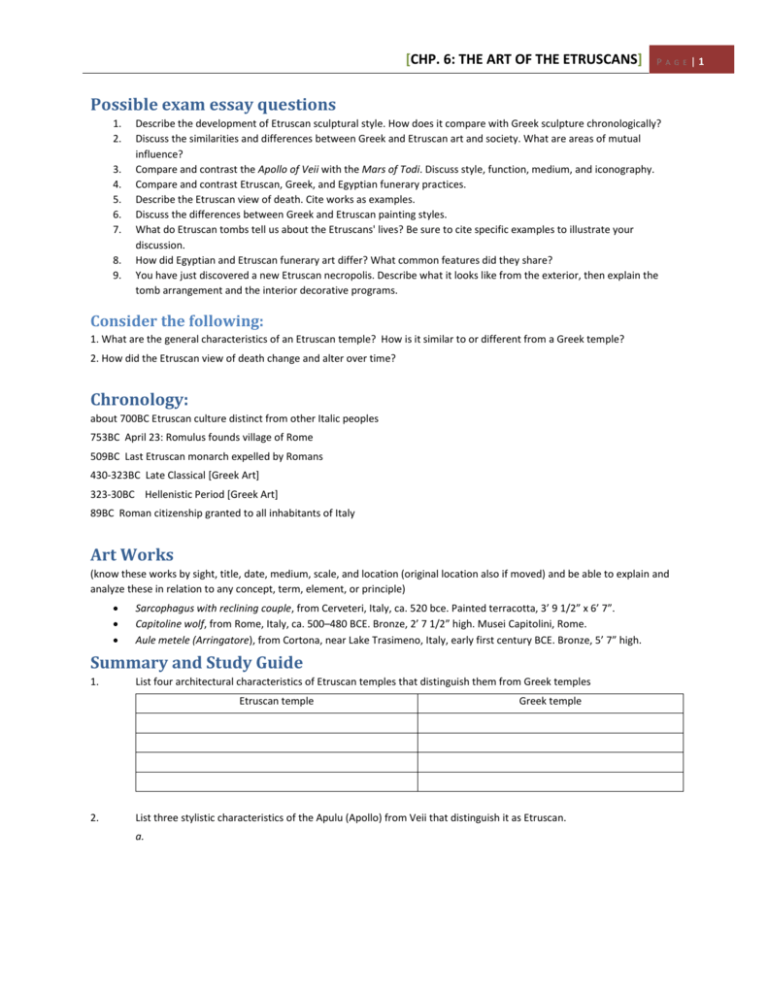vinfo-06-etrus
advertisement

[CHP. 6: THE ART OF THE ETRUSCANS] P A G E |1 Possible exam essay questions 1. 2. 3. 4. 5. 6. 7. 8. 9. Describe the development of Etruscan sculptural style. How does it compare with Greek sculpture chronologically? Discuss the similarities and differences between Greek and Etruscan art and society. What are areas of mutual influence? Compare and contrast the Apollo of Veii with the Mars of Todi. Discuss style, function, medium, and iconography. Compare and contrast Etruscan, Greek, and Egyptian funerary practices. Describe the Etruscan view of death. Cite works as examples. Discuss the differences between Greek and Etruscan painting styles. What do Etruscan tombs tell us about the Etruscans' lives? Be sure to cite specific examples to illustrate your discussion. How did Egyptian and Etruscan funerary art differ? What common features did they share? You have just discovered a new Etruscan necropolis. Describe what it looks like from the exterior, then explain the tomb arrangement and the interior decorative programs. Consider the following: 1. What are the general characteristics of an Etruscan temple? How is it similar to or different from a Greek temple? 2. How did the Etruscan view of death change and alter over time? Chronology: about 700BC Etruscan culture distinct from other Italic peoples 753BC April 23: Romulus founds village of Rome 509BC Last Etruscan monarch expelled by Romans 430-323BC Late Classical [Greek Art] 323-30BC Hellenistic Period [Greek Art] 89BC Roman citizenship granted to all inhabitants of Italy Art Works (know these works by sight, title, date, medium, scale, and location (original location also if moved) and be able to explain and analyze these in relation to any concept, term, element, or principle) Sarcophagus with reclining couple, from Cerveteri, Italy, ca. 520 bce. Painted terracotta, 3’ 9 1/2” x 6’ 7”. Capitoline wolf, from Rome, Italy, ca. 500–480 BCE. Bronze, 2’ 7 1/2” high. Musei Capitolini, Rome. Aule metele (Arringatore), from Cortona, near Lake Trasimeno, Italy, early first century BCE. Bronze, 5’ 7” high. Summary and Study Guide 1. List four architectural characteristics of Etruscan temples that distinguish them from Greek temples Etruscan temple 2. Greek temple List three stylistic characteristics of the Apulu (Apollo) from Veii that distinguish it as Etruscan. a. [CHP. 6: THE ART OF THE ETRUSCANS] Where was it originally placed? 3. What were the favorite materials of Etruscan sculptors? 4. Why is the Etruscan Capitoline Wolf (FIG. 3-6) so famous? 5. List two features of the magnificent bronze figure of Aule Matele that show the influence of the Romans. P A G E |2





